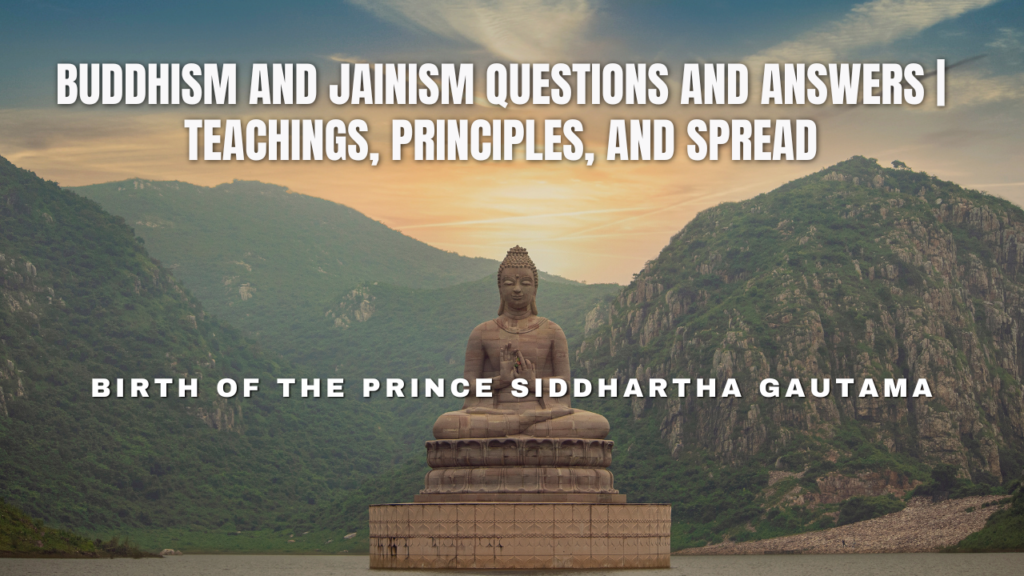Buddhism and Jainism Questions and Answers
Question 1: What was the impact of iron on the social conditions of the sixth century BC?
Ans: The use of iron led to the clearance of forests, expansion of agriculture, and growth of towns. This increased food production, created surplus, and encouraged trade and social mobility.
Question 2: What changes were witnessed in the political field during this period?
Ans: Small kingdoms and tribal republics emerged. Powerful Mahajanapadas like Magadha, Kosala, Vatsa, and Avanti rose. Monarchies became stronger, and republics (Ganasanghas) declined.
Question 3: State two causes for the rise of Buddhism.
Ans:
- Growing discontent with elaborate Vedic rituals.
- Desire for a simpler religion promoting equality.
Question 4: What were the four great sights?
Ans: The four sights seen by Prince Siddhartha were: an old man, a sick man, a dead body, and an ascetic.
Question 5: What was the Great Renunciation?
Ans: Prince Siddhartha renounced his home, family, and royal comforts at the age of 29 to seek the truth about human suffering.
Question 6: Why does the Bodhi tree deserve a special mention?
Ans: Gautama attained enlightenment under the Bodhi tree at Bodh Gaya, making it a sacred symbol in Buddhism.
Question 7: Where did the Buddha give his first sermon?
Ans: The Buddha gave his first sermon at Sarnath (Deer Park) near Varanasi.
Question 8: State the Four Noble Truths that form the crux of the Buddha’s teaching.
Ans:
- Life is full of suffering (Dukkha).
- Desire is the cause of suffering.
- Ending desire ends suffering.
- The Eightfold Path leads to the end of suffering.
Question 9: What was the Eightfold Path? What can it be otherwise referred to as?
Ans: The Eightfold Path consisted of right view, right intention, right speech, right action, right livelihood, right effort, right mindfulness, and right concentration. It is also called the Middle Path.
Question 10: What was achieved at the Buddhist council at Rajagriha?
Ans: The First Buddhist Council at Rajagriha compiled the teachings of the Buddha into the Vinaya Pitaka and Sutta Pitaka.
Question 11: Name the three baskets of the Buddha’s teachings.
Ans: The Tripitaka: Vinaya Pitaka, Sutta Pitaka, and Abhidhamma Pitaka.
Question 12: What do you understand by the Buddhist Sangha?
Ans: The Sangha was the monastic order of monks and nuns who spread Buddhism and followed a disciplined life of renunciation.
Question 13: Which religion would you associate with a Tirthankara?
Ans: Jainism.
Question 14: Name the 23rd and 24th Tirthankaras.
Ans: 23rd – Parshvanatha; 24th – Mahavira.
Question 15: Who was called Jina and why?
Ans: Vardhamana Mahavira was called Jina (the conqueror) because he conquered his desires and attained spiritual victory.
Question 16: Name any two towns in which Mahavira preached Jainism.
Ans: Vaishali and Rajagriha.
Question 17: State the basic tenets of Jainism.
Ans: The five great vows (Mahavratas):
- Ahimsa (non-violence)
- Satya (truth)
- Asteya (non-stealing)
- Brahmacharya (celibacy)
- Aparigraha (non-possession).
Question 18: What do you understand by:
i. Siddhashila – The abode of liberated souls.
ii. Three Ratnas – Right faith, right knowledge, and right conduct.
Question 19: Name the Jain religious text.
Ans: The Angas.
Question 20: Which were the two sects of the Jain religion?
Ans: Shvetambaras (white-clad) and Digambaras (sky-clad).
Question 21: Discuss the spread of Jainism.
Ans: Jainism spread in regions like Bihar, Rajasthan, Gujarat, Karnataka, and Madhya Pradesh through monks and traders. Royal patronage from kings like Chandragupta Maurya also aided its spread.
Question 22: State the factors that checked the spread of Jainism.
Ans: Strict vows of asceticism, emphasis on extreme non-violence, and use of Prakrit instead of Sanskrit limited its wider appeal.
Question 23: Write about the importance of Buddhism and Jainism.
Ans: Both religions opposed caste, simplified rituals, encouraged equality, promoted non-violence, and contributed to Indian art, architecture, and philosophy.
Question 24: State one point of similarity between Buddhism and Jainism.
Ans: Both opposed Vedic rituals and animal sacrifices, and emphasized non-violence.
Question 25: How would you distinguish between Buddhism and Jainism? State any two features.
Ans:
- Jainism emphasized extreme asceticism, while Buddhism advocated the Middle Path.
- Jainism believed in soul (jiva) and karma, while Buddhism denied the existence of a permanent soul (anatta).
Question 26: Buddhism and Jainism emerged as a reaction to Brahminism. In this context, discuss:
a. Causes for the deep resentment among the Vaishyas – Excluded from high ritual positions despite wealth.
b. Complexities of religious observances – Elaborate and costly rituals of Brahmanism caused dissatisfaction.
c. Vedic rituals adding to the misery of agriculturists – Animal sacrifices and heavy offerings burdened farmers.
Question 27: With reference to Buddhism, answer the following:
a. Gautama Buddha was born in 563 BC at Lumbini (Nepal).
b. Great Renunciation: He left his family and kingdom at 29 to find a solution to human suffering.
c. Main teachings: Four Noble Truths, Eightfold Path, Middle Way, rejection of caste, emphasis on compassion.
d. Reasons for spread: Simple teachings, use of Pali language, monastic order, royal patronage (Ashoka), missionary zeal.
Question 28: With reference to Jainism, answer the following:
a. Tirthankaras were spiritual teachers who showed the path of salvation.
b. Mahavira attained Kaivalya (omniscience) at 42 years of age at Jrimbhikagrama.
c. Main teachings: Five vows (Ahimsa, Satya, Asteya, Brahmacharya, Aparigraha), stress on asceticism, karma, and rebirth.
d. Purvas were ancient texts now lost, while Angas are canonical scriptures of Jainism.

